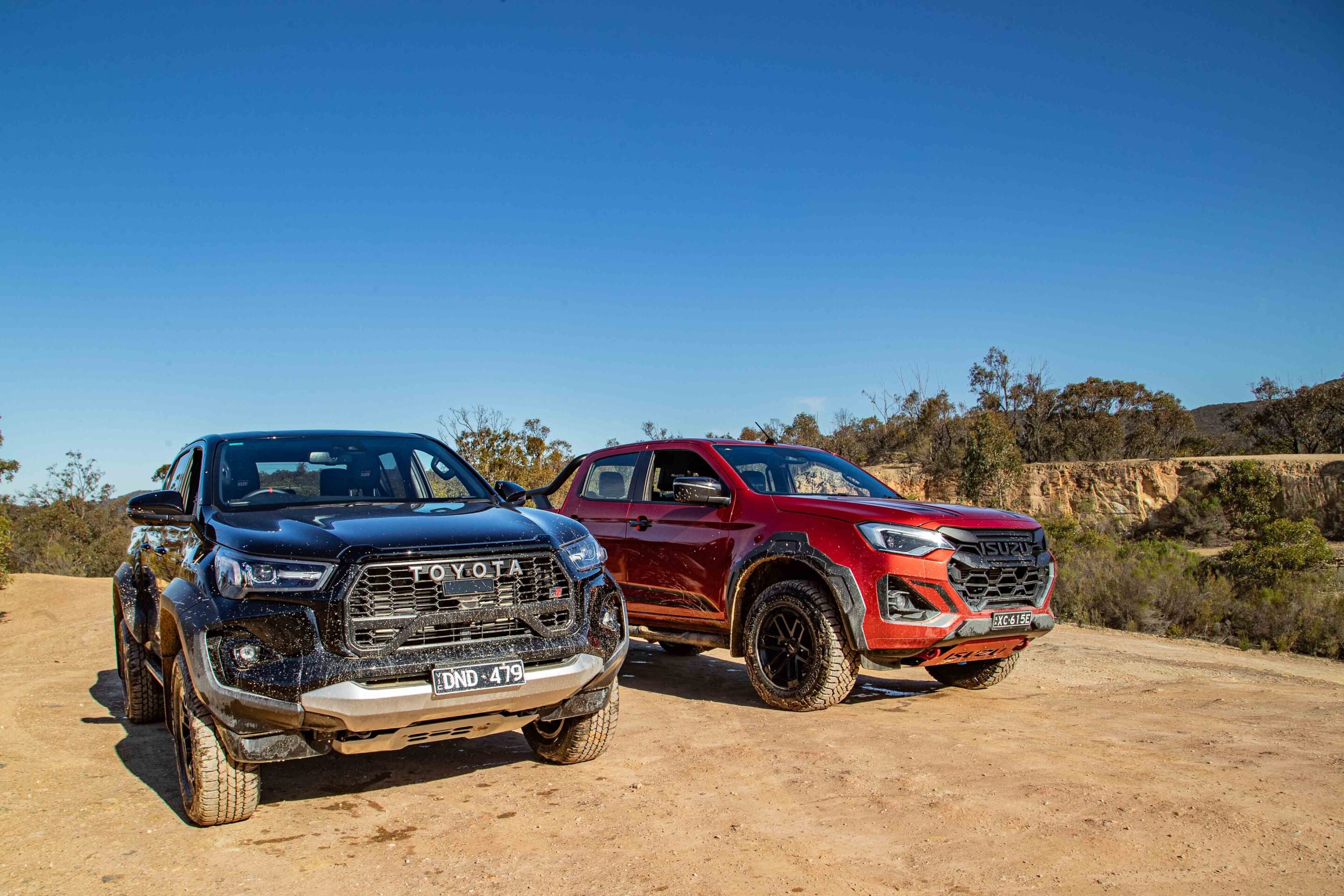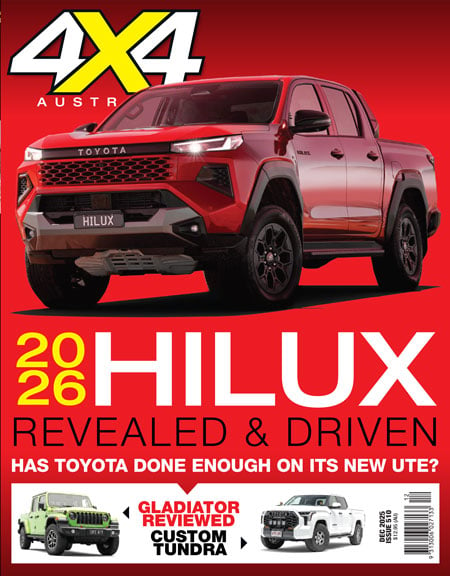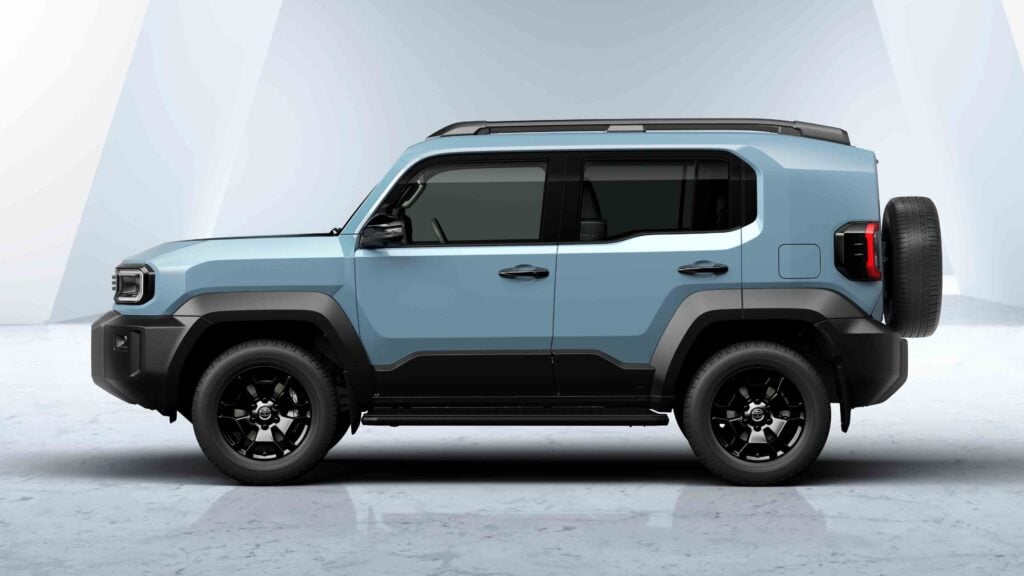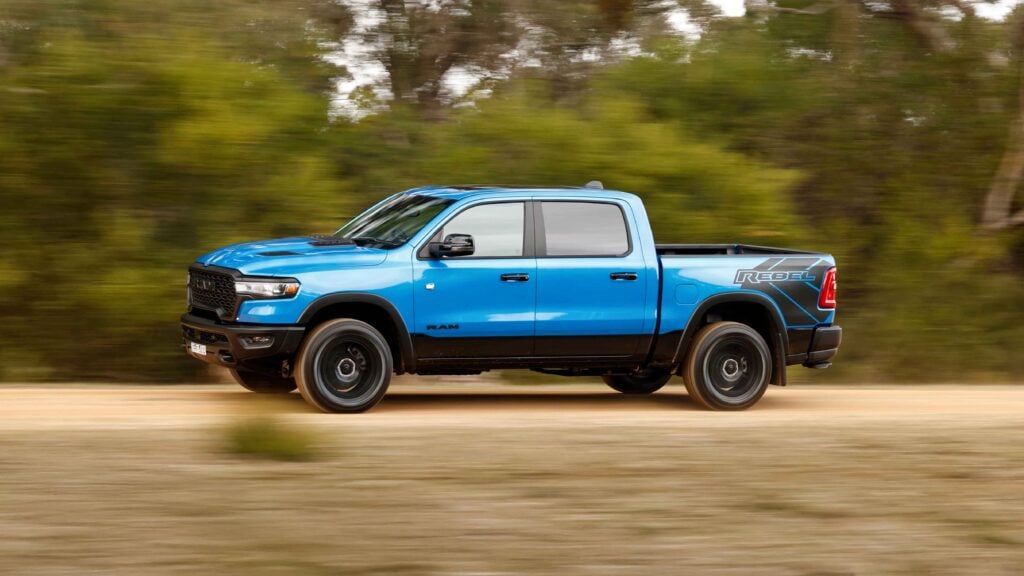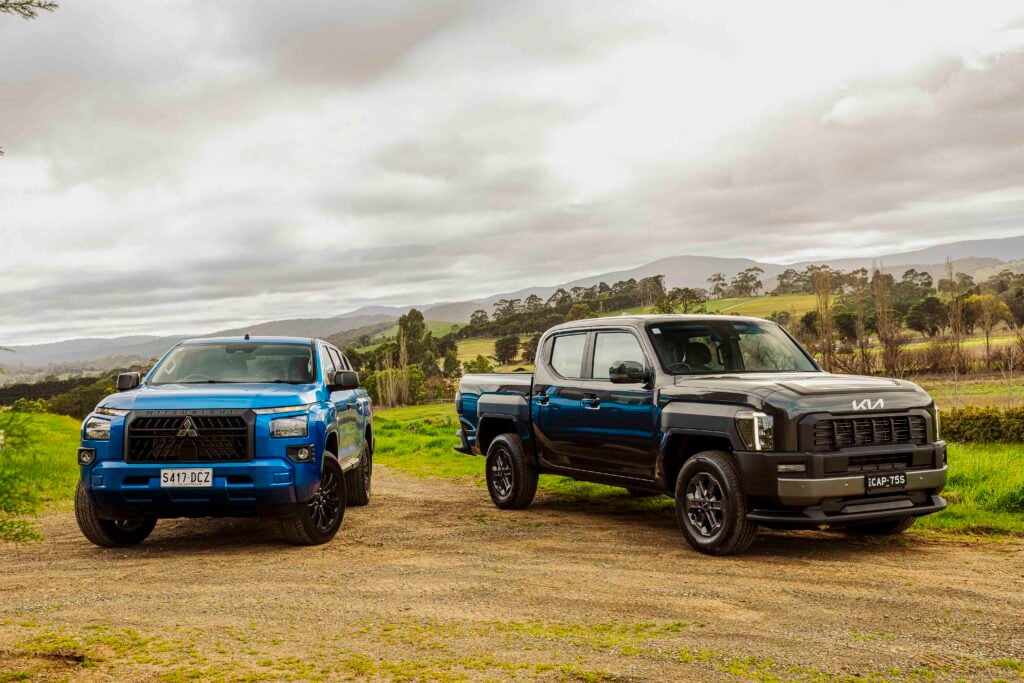Improved 4×4 utes developed in Australia and tuned for local conditions have become common among the big-name manufacturers, with most upgrades focused on suspension, tyres and factory add-ons.
Two of the more popular examples come from two of the country’s best-selling brands: the Toyota HiLux GR Sport and the Isuzu D-MAX Blade. So we’re putting them head-to-head to see which brand does it better.
We’re chasing answers for three core types of ute buyers: tradies who need strength, load-carrying and durability; tourers looking for traction, comfort and capability when fully loaded; and weekend warriors chasing a mix of tech, safety and that tough-truck image. Both of these utes claim to tick all the boxes straight off the showroom floor. But which one actually delivers? That’s what we’re here to find out.
In the Sunstone Mica corner is the Isuzu D-MAX Blade – Isuzu UTE Australia’s locally engineered flagship dual-cab 4×4, positioned above the popular X-Terrain. Based on the mid-spec LS-U, the Blade has been reworked with input from Walkinshaw to better suit local terrain and Aussie buyer expectations. It looks the part too, with satin-black striping, flares, red front-rated recovery points and Blade-exclusive alloys wrapped in 275/65R17 Goodyear Wrangler Duratracs.
Under the bonnet is the familiar 3.0-litre turbo-diesel (140kW/450Nm), paired with a six-speed auto, switchable Terrain Command 4×4 system and a rear diff lock.
In the Eclipse Black corner is Toyota’s HiLux GR Sport, launched in 2023 as the range-topping variant above the Rogue. It shares the same platform but scores a power bump, uprated suspension, wider tracks and a handful of styling tweaks. It retains the 2.8-litre 1GD turbo-diesel for 165kW and 550Nm, sent through Toyota’s familiar six-speed auto.
Neither is a Raptor rival – let’s not go there. But both are built to be the most capable and complete HiLux and D-MAX variants their respective makers have ever offered.
JUMP AHEAD
- Pricing and value
- Engine and drivetrain
- Tyres and suspension
- Off-road capability
- On-road driving
- Payload and towing
- Recommended upgrades
- Cabin and technology
- Safety features
- Warranty and servicing
- Final verdict
- Specs
Pricing and value
At $76,990 drive-away, the D-MAX Blade is the most expensive D-MAX ever sold. It builds on LS-U underpinnings with Walkinshaw-tuned suspension, underbody protection, a 29mm lift and a range of cosmetic upgrades. Compared to the $67,990 X-Terrain, it’s more rugged and less plush – aimed squarely at buyers who value off-road grit over city shine.
The HiLux GR Sport lists at $73,990 plus on-roads. Factor in dealer delivery and rego, and it comes in around $77K drive-away – putting it neck-and-neck with the Blade. For the money, buyers get a wider track, suspension upgrades, more power and torque, and the added appeal of that GR-branded halo.
The closest rival to both is the Ford Ranger Tremor, priced at $69,690 plus on-roads. Based on the XLT, it offers comparable off-road gear, full-time 4×4, and a strong value proposition.
Engine and drivetrain
The Blade runs Isuzu’s proven 4JJ3-TCX – a 3.0-litre four-cylinder turbo-diesel built for longevity and low-stress torque.
It’s long been the engine of choice for fleets and farmers, and in Blade trim it remains unchanged from lower grades, producing 140kW and 450Nm. Power is delivered via a six-speed Aisin auto and switchable part-time 4×4. The HiLux GR Sport runs Toyota’s familiar 1GD-FTV 2.8-litre turbo-diesel, but with a high-output tune that lifts outputs to 165kW and 550Nm.
Both utes run six-speed Aisin automatics, but their personalities are distinct. The D-MAX favours smoothness, with early upshifts and a relaxed torque converter. The HiLux, by contrast, holds gears longer, kicks down more aggressively, and gives the GR Sport a noticeably sharper throttle feel.
Both claim 8.0L/100km, but on test the Blade hovered closer to 9.0L, while the HiLux crept up to 10.0L. It’s acceptable for dual-cab utes, but neither could be called frugal when driven hard.
Tyres and suspension
Tyres played a pivotal role in this comparison – as they do in real-world off-road performance.
The Blade runs aggressive 275/65R17 Goodyear Wrangler Duratracs – a rare LT-spec tyre fitted from the factory. With deep lugs, strong sidewalls and serious off-road bite, it’s one of the few showroom utes that doesn’t need a tyre upgrade straight away. The GR Sport rolls on 265/65R17 Bridgestone Dueler A/T 002s – newer, road-biased all-terrains that perform well on gravel and bitumen, but don’t match the Goodyears for off-road grip or self-clearing ability.
Suspension-wise, the Blade benefits from Walkinshaw’s input: a 29mm lift courtesy of a coil perch spacer and rear lift block, Monroe twin-tube shocks, and matched valving to suit extra weight and travel. It retains OEM spring rates – a compromise aimed at preserving ride comfort, but still enough to improve articulation. The HiLux runs uprated springs and in-house-developed monotube dampers, tuned by Toyota for the GR Sport. It feels firmer and more planted on the move, helped by its wider track and revised suspension geometry.
The verdict? The Blade has the edge on traction, but the GR Sport feels more refined on-road – and would be a different beast with better tyres.
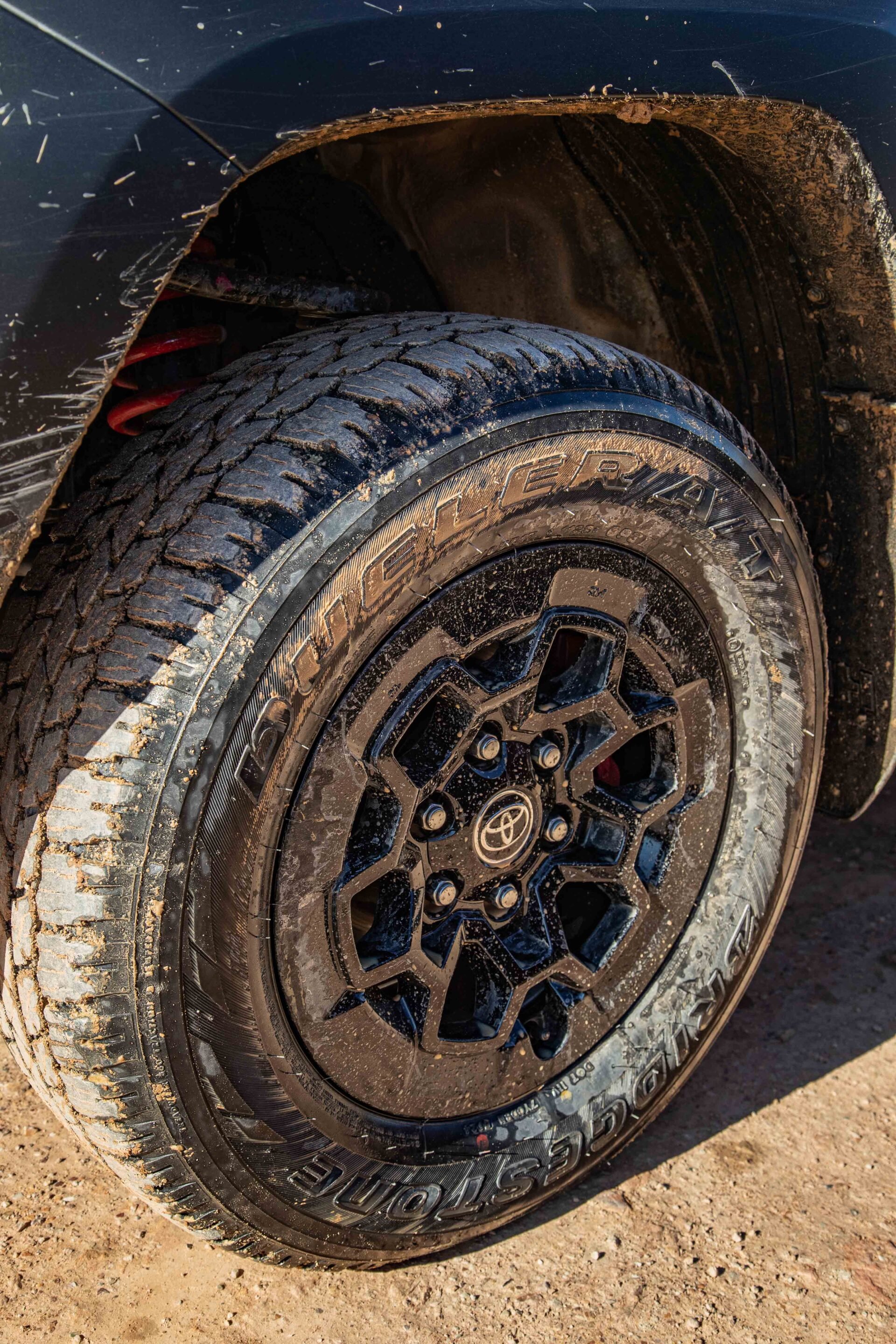
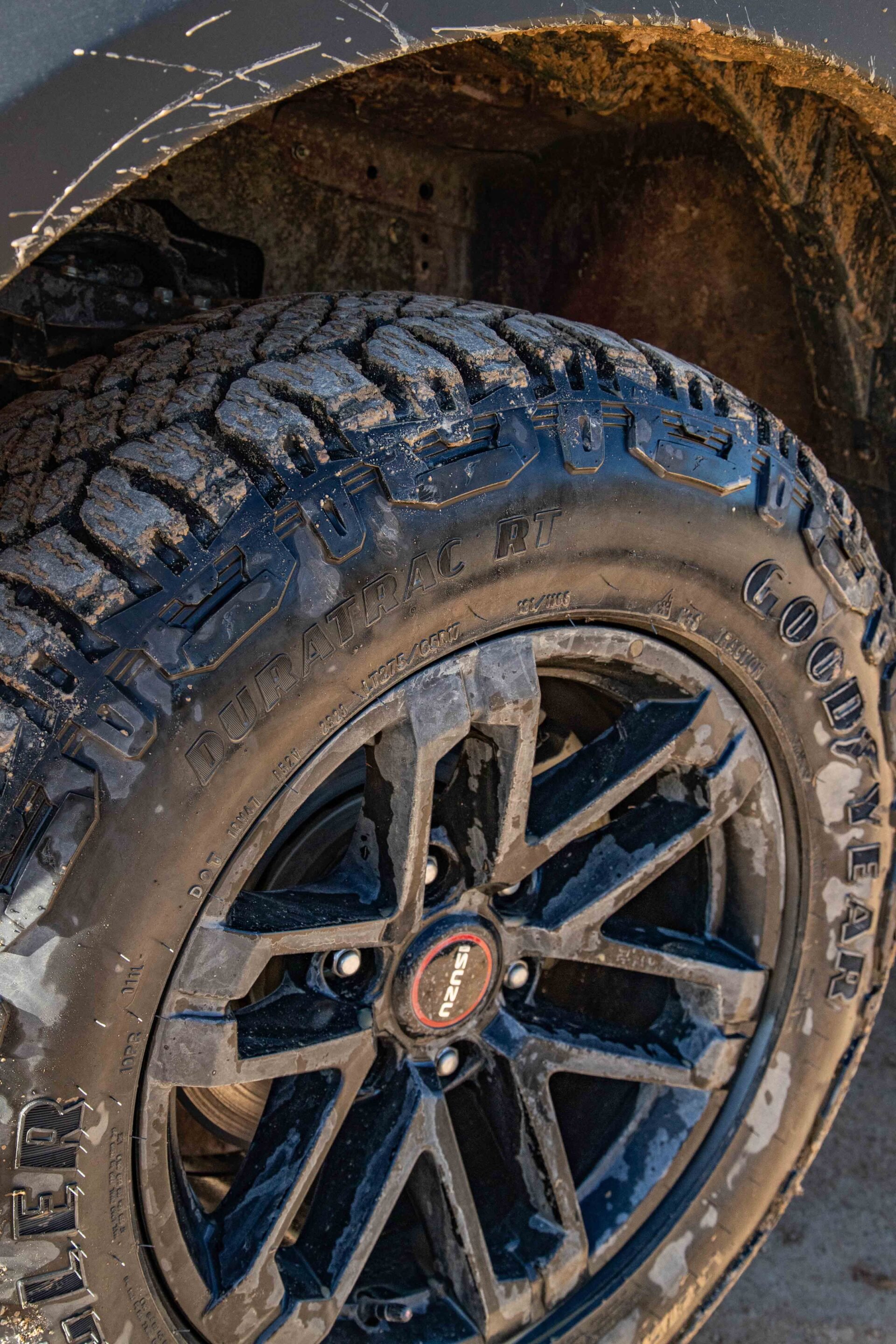
Off-road performance
We put both utes through the same set of off-road challenges at road pressures – including steep clay climbs, rutted cross-axle sections, shelfy rock steps and a water crossing – all tackled without airing down.
With Rough Terrain Mode engaged, the Blade was near flawless. Its brake-based traction control kicked in quickly and confidently, pulling it through ruts and climbs with minimal throttle. It made tough sections look easy – a system that genuinely flatters the driver.
Without Rough Terrain Mode engaged, the Blade struggled. It faltered in cross-axle tests and needed multiple throttle stabs to break free. Lower ground clearance and tighter approach and departure angles also meant the steel sidesteps and rock sliders took frequent hits – though the front bash plates and recovery points held up well.
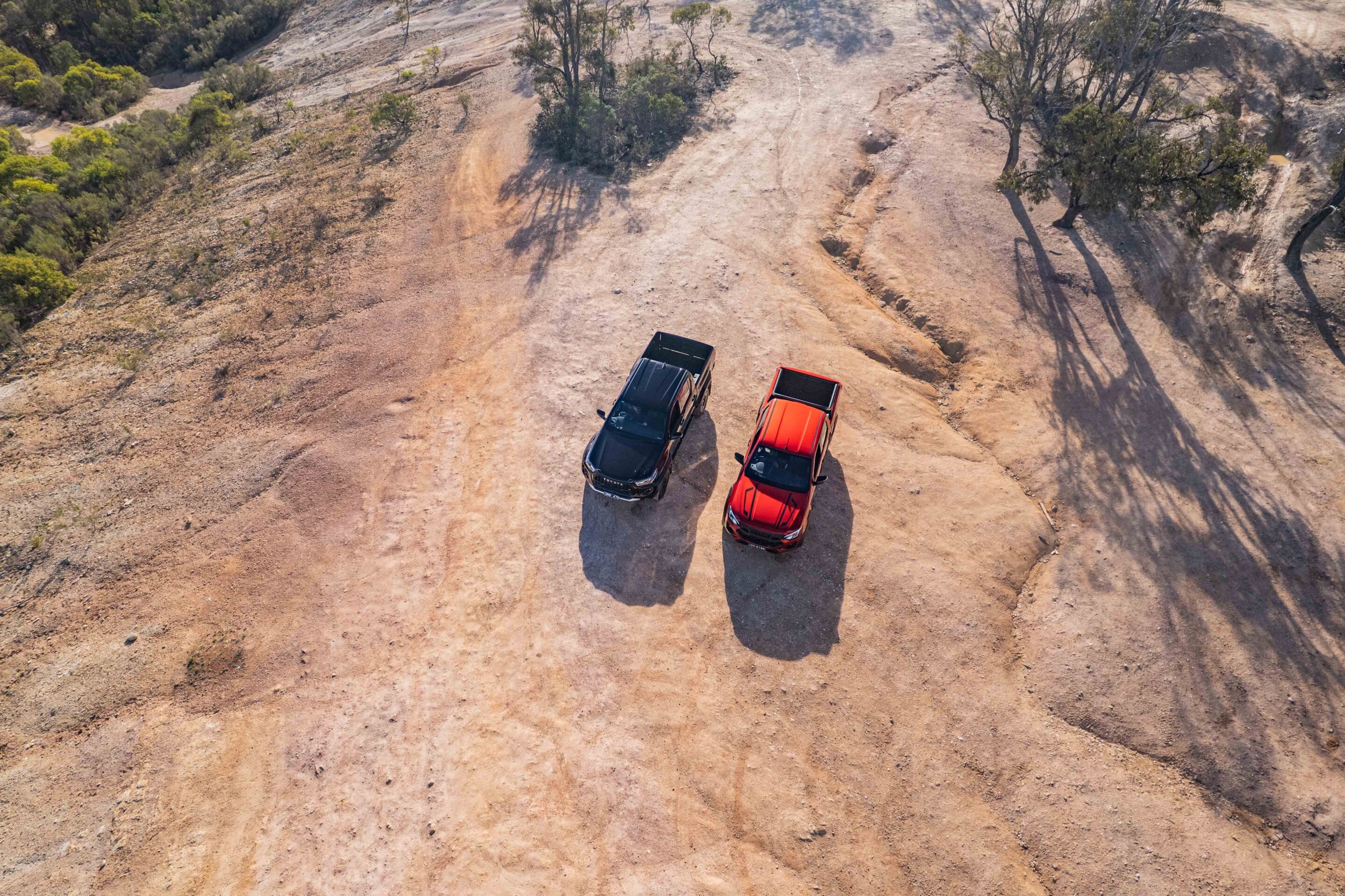
The GR Sport impressed with better suspension travel and more confidence over uneven terrain. It made solid progress with just the centre diff locked, thanks largely to its articulation. But without advanced traction control or terrain modes, it eventually met its limit – quite literally – needing three full-bore attempts at the steepest climb before we called it off to prevent damage.
With better tyres, the HiLux might’ve matched – or even outperformed – the Blade. But straight off the showroom floor, the Isuzu’s off-road kit, particularly its traction control and tyres, gave it a clear edge. A genuine surprise.
On-road driving
This is where the tables turned. On sealed roads and faster dirt tracks, the GR Sport stood out as the better drive.
The GR Sport’s ride is planted, composed and surprisingly engaging – easily the most enjoyable HiLux to drive at pace. The wide track, GR-specific damping and aggressive transmission tune give it a nimble, confident feel. It encourages faster cornering and delivers better isolation over rough backroads.
The Blade – while a clear improvement over any previous D-MAX – still rides like a ute first. It feels heavier, less responsive, and a bit more unsettled over fast bumps or mid-corner corrugations. Walkinshaw’s tweaks help, particularly with body control, but the gap to the GR Sport is significant.
The GR Sport also holds a clear power advantage. With 165kW and 550Nm, it pulls harder than the D-MAX’s 140kW/450Nm, and its gearbox is quicker to respond. Whether overtaking, climbing hills or carrying a load, the Toyota feels more alive. When it comes to daily drivability, the GR Sport takes the win.
Payload and towing
Let’s talk numbers. The HiLux GR Sport has a kerb weight of 2315kg and a GVM of 3050kg, leaving a modest payload of 735kg. It’s rated to tow 3500kg, but GCM is capped at 5850kg.
The D-MAX Blade is lighter, with a 2130kg kerb weight and 3100kg GVM – giving it a far healthier 970kg payload. Towing matches the HiLux at 3500kg, but its GCM stretches to 6000kg.
Neither ute comes close to matching the Ford Ranger’s clever in-tub tie-down system, with its movable hooks and smart cargo solutions. The D-MAX Blade scores a mandrel-bent black sports bar – tough-looking, but mostly for show. Inside both tubs you’ll find basic fixed tie-down loops – fine for light gear, but lacking flexibility. There’s no tub lighting, no power outlets, and no rail-based cargo management. Tradies and tourers will need to budget for upgrades.
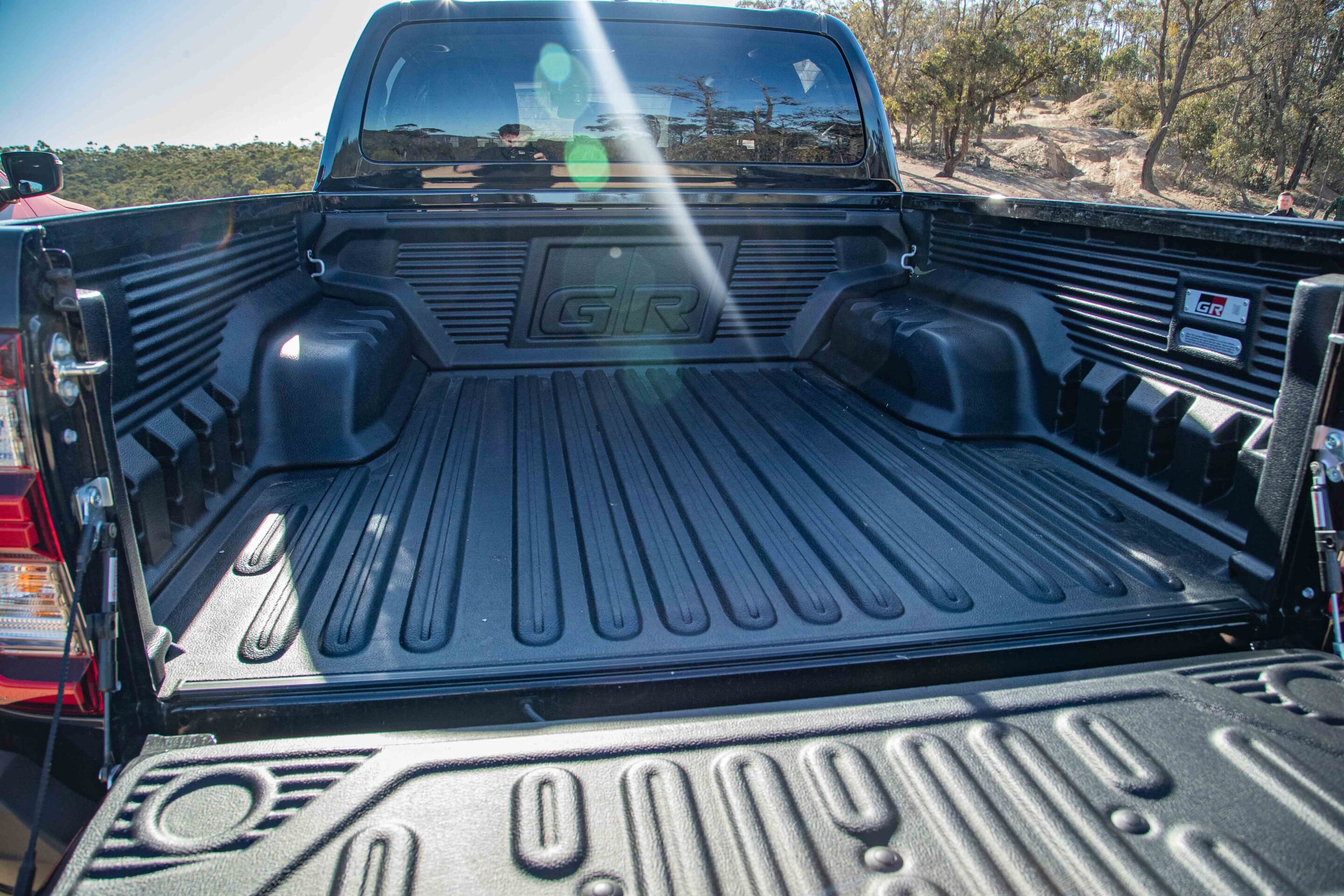
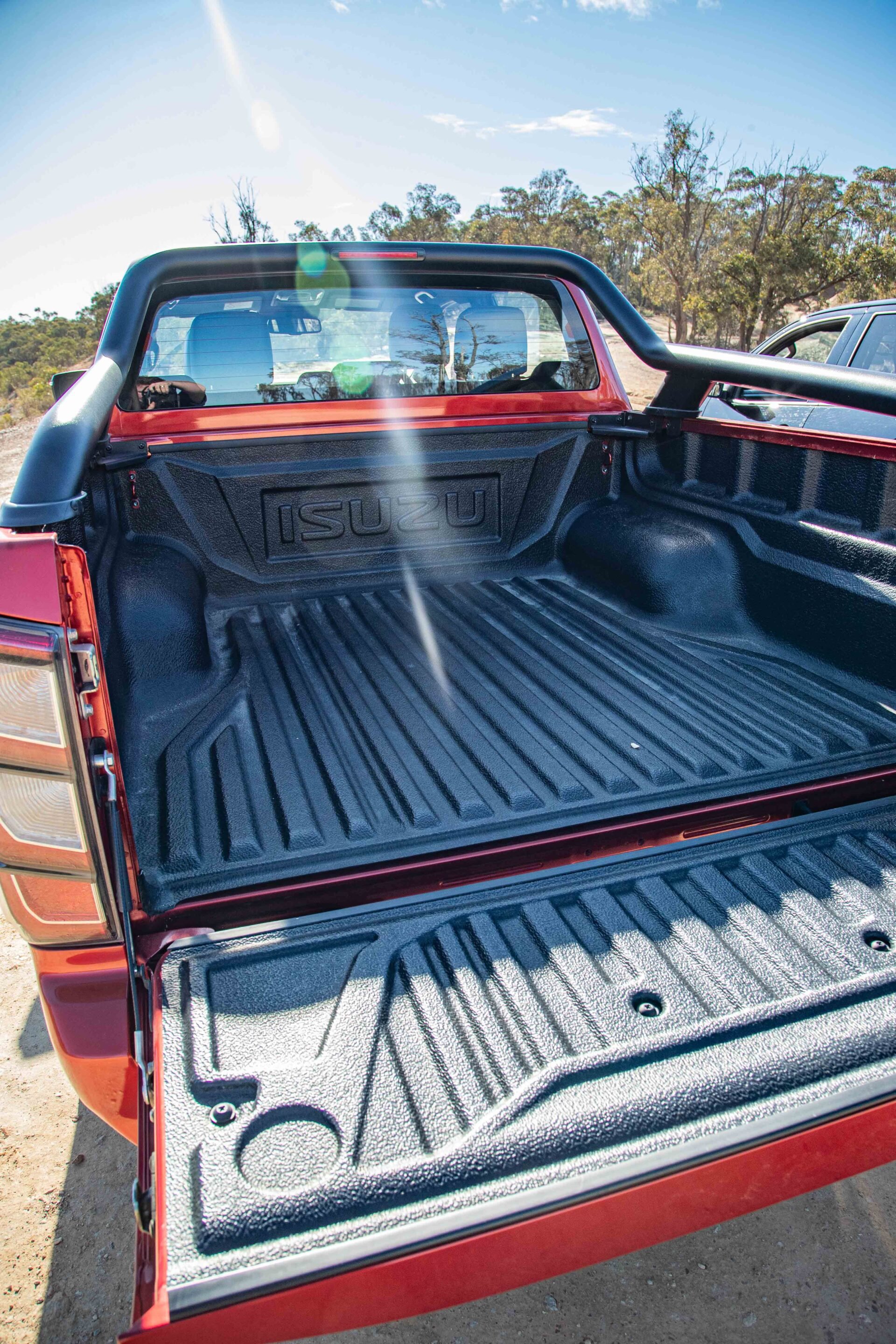
Now let’s test that with a real-world scenario – hitching up a 3500kg trailer. Using GCM maths (GCM – kerb weight – trailer), the HiLux is left with just 35kg of legal payload. That’s not even enough for a driver and a backpack. I weighed more than 35kg when I was six. The Blade, under the same load, gives you 370kg of remaining payload. Still tight – but workable. You can bring the driver, some tools, gear, and a bit of fuel and food. That’s the difference between a functional workhorse and one parked at the weighbridge.
Both utes are better suited to towing up to around 2800kg. But legally and practically, the Blade is the only one you’d take touring or towing without reaching for a calculator.
Recommended upgrades
Out of the box, both utes are capable – but with a few smart upgrades, each can be better tailored to the job at hand.
For tradies and tourers, the D-MAX’s generous payload and GCM mean a GVM upgrade isn’t essential – but it’s still worth considering if you’re adding a canopy, long-range tank or serious 12V setup. Ironman’s 40mm lift with GVM kit offers both 400kg and 650kg rear spring options – a genuinely useful level of customisation.
The Blade’s factory lift is basic – just a perch and block setup. Upgrading to full replacement springs and dampers would improve load-carrying and likely ride comfort too. We’d also recommend aftermarket upper control arms to improve camber control, particularly under load or at full droop. The MY25 range brings updated front knuckles, but there’s still room for improvement.
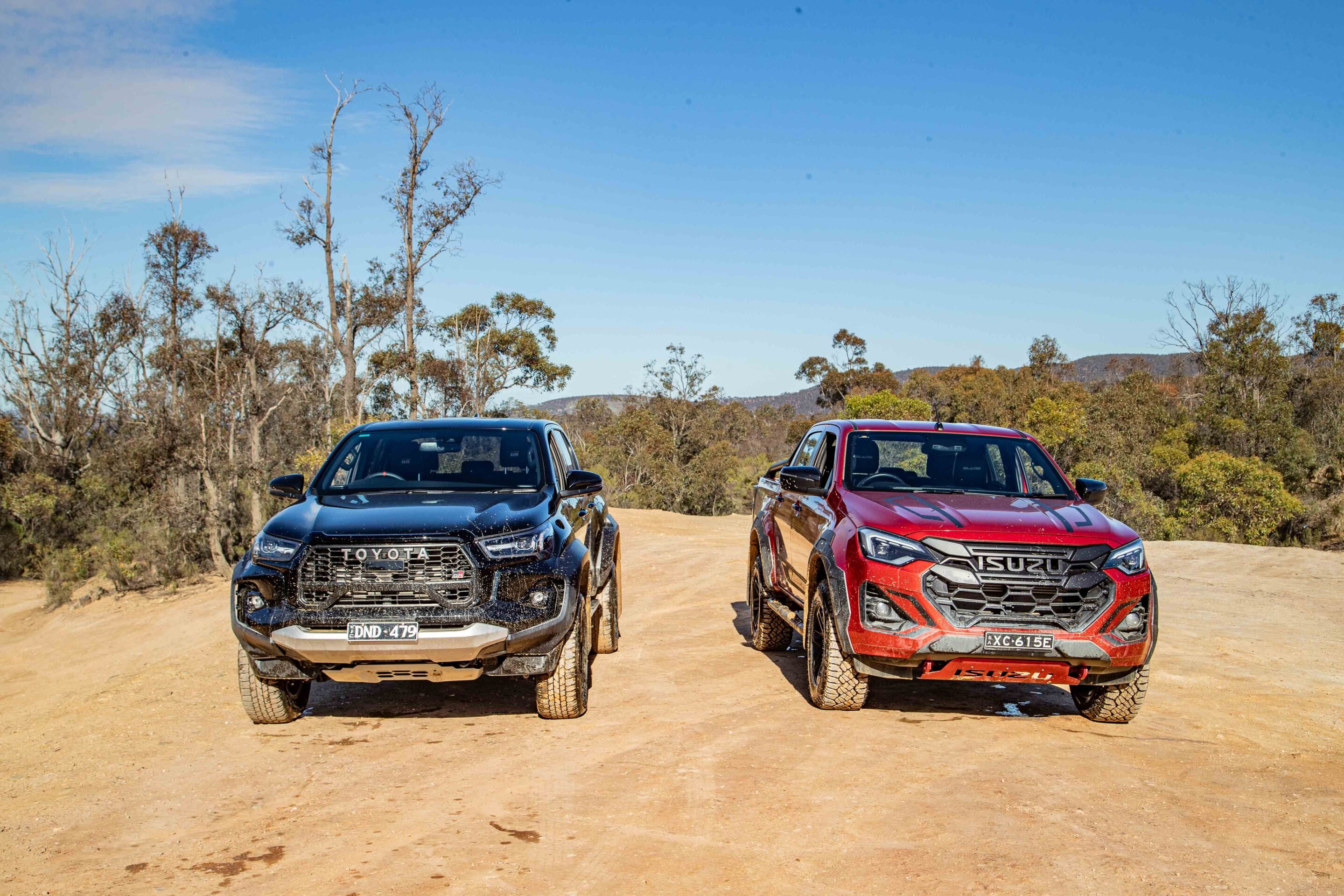
The GR Sport’s most urgent upgrade is tyres. A set of taller, more aggressive all-terrains would deliver a big boost in off-road confidence. Frontal protection is also a smart addition for both utes – neither comes with a bullbar, and the Blade’s excellent integrated light bar is left exposed to the first roo strike.
All buyers – even weekend warriors – will benefit from better tub storage. A Utemaster hard lid or roller cover, roof platform, or dual-battery setup in the tub can turn either ute into a full-time adventure rig. Add comms, recovery gear and a long-range tank for touring, and you’ve got a serious outback contender.
Cabin and technology
This is where the age gap between the two platforms really shows.
While the D-MAX dates back to 2020, the HiLux GR Sport rides on a platform that first launched in 2015 – and it feels it. The dash design is curved but dated, the infotainment screen is small and sluggish, and the camera resolution is so grainy it’s barely usable. It technically has a 360-degree camera system, but the low-def display seriously limits its value.
Where the HiLux shines is seating comfort. The fabric bucket seats are excellent – breathable, supportive, and genuinely comfortable on long drives. They’re among the best pews you’ll find in any dual-cab ute.
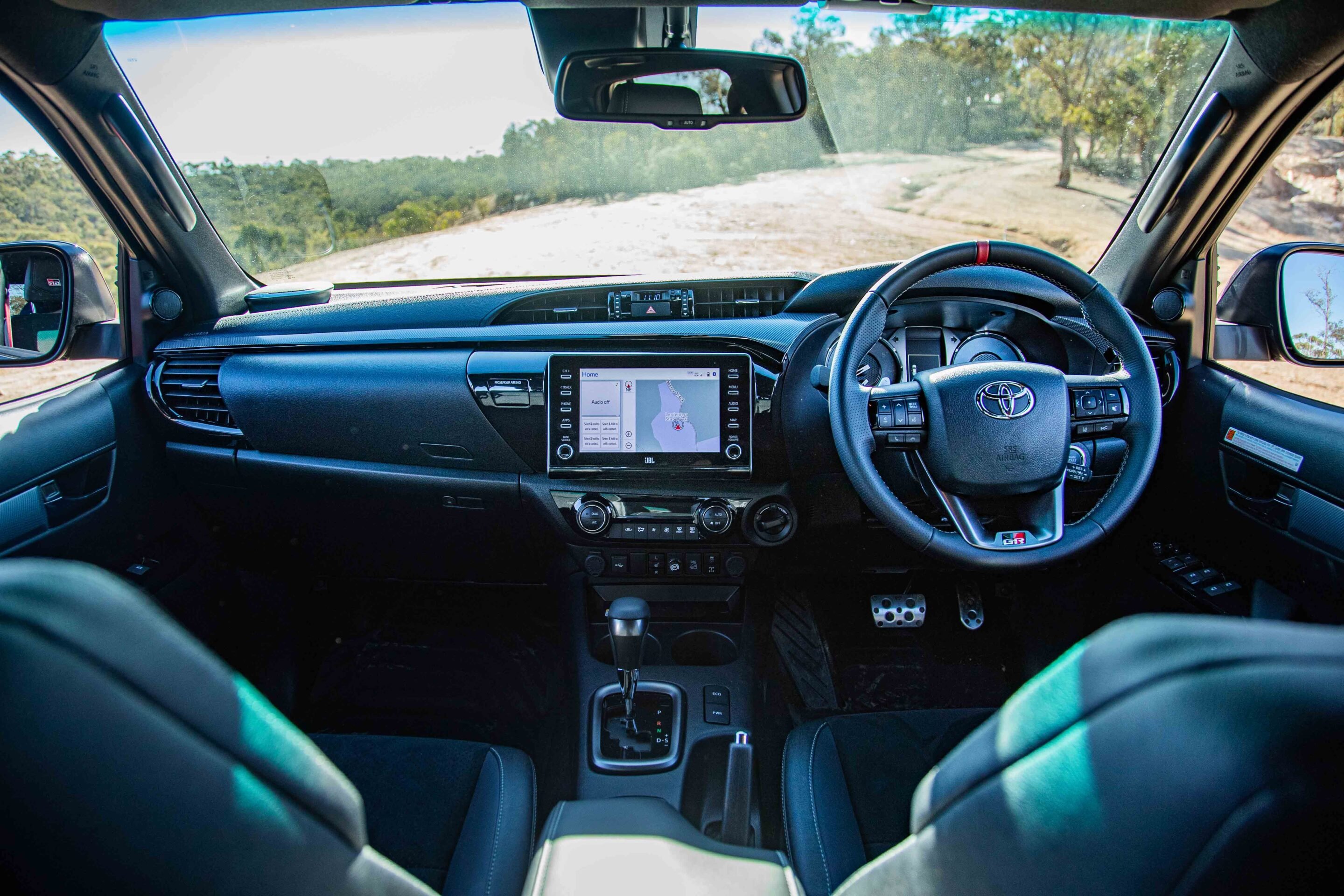
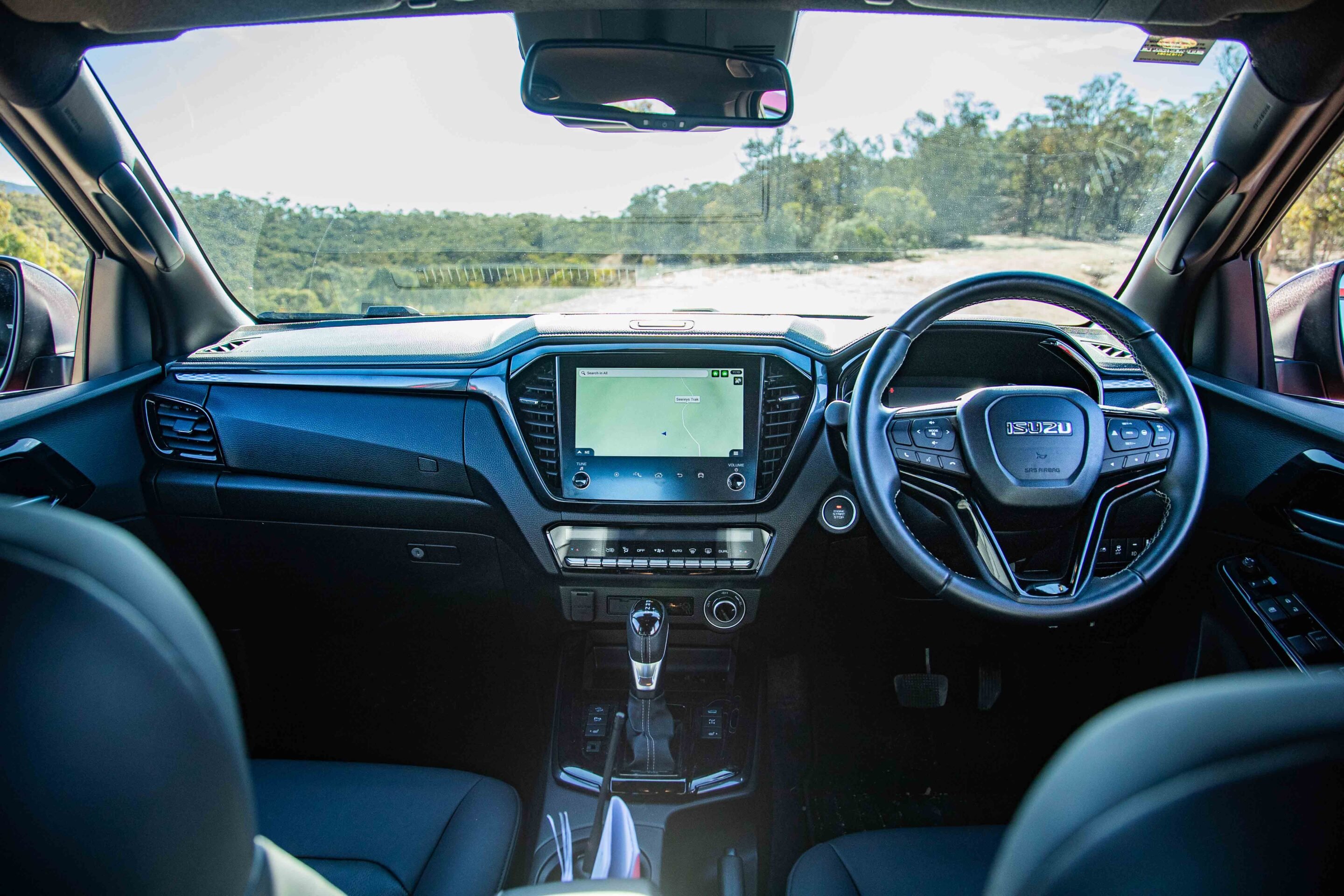
The D-MAX Blade, by contrast, runs on a five-year newer interior platform. It’s not as tightly screwed together – there’s more trim flex and the odd squeak – but it wins on tech and functionality. The infotainment system is quicker, Apple CarPlay is faster and more reliable, and the reversing camera is vastly clearer. It also offers more USB ports and better charging access, though it lacks the 220V/100W outlet found in the HiLux’s centre console.
Both utes feature electric driver’s seats and heated front seats, but the D-MAX feels more modern and user-friendly overall. The HiLux may be better built and more refined, but the D-MAX wins where it matters most – tech, connectivity and visibility – all crucial for tradies and tourers alike.
Safety features
Both utes come equipped with a full active safety suite – including AEB, blind spot monitoring, rear cross-traffic alert and adaptive cruise control. But the way they behave on the road couldn’t be more different.
The HiLux runs hydraulic power steering, so it doesn’t offer active lane-keeping – just a basic warning. Some drivers will appreciate the simplicity. Its adaptive cruise control is similarly limited, cancelling below 30km/h and unable to bring the ute to a full stop in traffic.
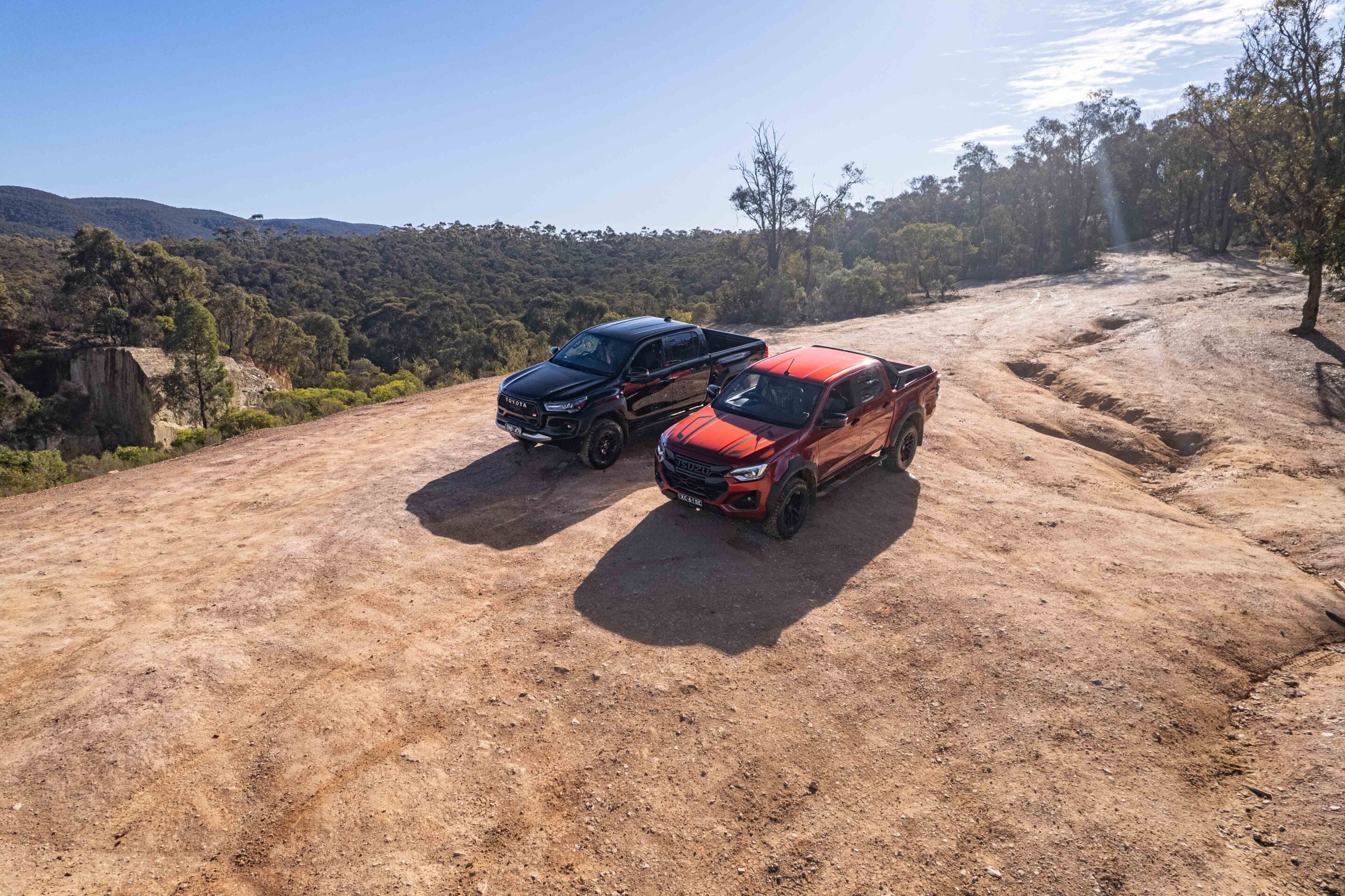
The D-MAX, meanwhile, uses electric power steering and includes active lane-keeping assist – it’ll steer you back between the lines, and often does so quite aggressively. It works, but the intervention can feel abrupt and polarising. Thankfully, it can be switched off by holding the button down for a few seconds.
Where the Blade really shines is in tyre monitoring. The HiLux simply chimes when pressure drops, with no live readout. The D-MAX, on the other hand, provides individual tyre pressure and temperature readings – displayed on either the dash or infotainment screen. It’s the best TPMS in the segment.
If you prefer less electronic interference, the HiLux keeps things simpler. If you want more data and driver assist tech, the D-MAX takes the lead. Call this round a draw.
Warranty and servicing
Upfront, they’re neck and neck. The HiLux GR Sport lists at $73,990 plus on-roads, while the D-MAX Blade is $76,990 drive-away. Once you factor in rego and dealer delivery, both end up at roughly the same drive-away price.
The big difference comes with long-term ownership. The HiLux includes a five-year, unlimited-kilometre warranty, while the D-MAX stretches to six years – capped at 150,000km. That means high-mileage drivers may reach the D-MAX limit sooner, but most owners will benefit from the extra 12 months of coverage.
Servicing is where the Blade claws ahead. The HiLux requires servicing every 10,000km or six months – that’s 15 visits over 150,000km, totalling around $4350 (at roughly $290 per service). The D-MAX stretches intervals to 15,000km or 12 months, needing just 10 services over the same distance, totalling $4490.
While the total cost over 10 years is similar, the D-MAX offers fewer service visits, less downtime, and an extra year of warranty – a clear win for tradies and tourers keeping one eye on the clock and the other on the bottom line.
Final verdict
Stack it all up – capability, comfort, tech, and ownership – and the D-MAX Blade takes the overall win. It’s better equipped out of the box, more capable off-road, offers more usable payload and towing capacity, and delivers stronger long-term value with less time off the road.
That said, choosing the right ute still depends on who you are. Tradies will appreciate the Blade’s longer service intervals, higher payload and lower running costs. The HiLux holds the edge on resale – no surprise there – but it’s less flexible when loaded or towing.
Tourers should also lean toward the Blade. Its higher GCM, superior traction tech and factory-fit, outback-ready tyres make it the smarter choice for long-distance work – especially with a full load of gear. Weekend warriors might still prefer the HiLux. It’s sharper on-road and feels livelier behind the wheel. Throw on a decent set of tyres and it’ll go nearly anywhere the Blade can.
But for everyone else – especially those who load up, tow often and travel far – the D-MAX Blade is the more complete dual-cab ute, right from the showroom floor.
Specs: D-MAX Blade and HiLux GR Sport
| Isuzu D-MAX Blade | Toyota HiLux GR Sport | |
|---|---|---|
| Price | $76,990 drive-away | $73,990 +ORC (approx. $77,000 on-road) |
| Engine | 4JJ3-TCX 4cyl turbo-diesel | 1GD-FTV 4cyl turbo-diesel |
| Capacity | 2999cc | 2755cc |
| Max power | 140kW @ 3600rpm | 165kW @ 3400rpm |
| Max torque | 450Nm @ 1600-2600rpm | 550Nm @ 1600-2800rpm |
| Transmission | Aisin 6-speed automatic | Aisin 6-speed automatic |
| 4×4 system | Part-time 4×4 with high and low range, Terrain Command and rear diff lock | Part-time 4×4 with high and low range, and rear diff lock |
| Construction | Dual-cab ute body on ladder frame chassis | Dual-cab ute body on ladder frame chassis |
| Front suspension | Independent, double wishbones, coil springs and Monroe twin-tube shocks | Independent, double wishbones, coil springs and KYB monotube shocks |
| Rear suspension | Leaf springs, Monroe twin-tube shocks with lift blocks | Leaf springs, KYB monotube shocks |
| Tyres | 275/65R17 Goodyear Wrangler Duratrac (LT-AT) | 265/65R17 Bridgestone Dueler A/T 002 |
| Weight (kerb) | 2130kg | 2315kg |
| GVM | 3100kg | 3050kg |
| GCM | 6000kg | 5850kg |
| Towing capacity | 3500kg braked | 3500kg braked |
| Payload | 970kg | 735kg |
| Seats | 5 | 5 |
| Fuel tank | 76L | 80L |
| ADR fuel consumption | 8.0L/100km | 8.0L/100km |
| On-test consumption | 9.0L/100km | 10.0L/100km |
| Approach angle | 29.2 | 30 |
| Departure angle | 19.2 | 26 |
| Breakover angle | 25.2 | 26 |
| Ground clearance | 244mm | 265mm |
| Wading depth | 800mm | 800mm |
We recommend
-
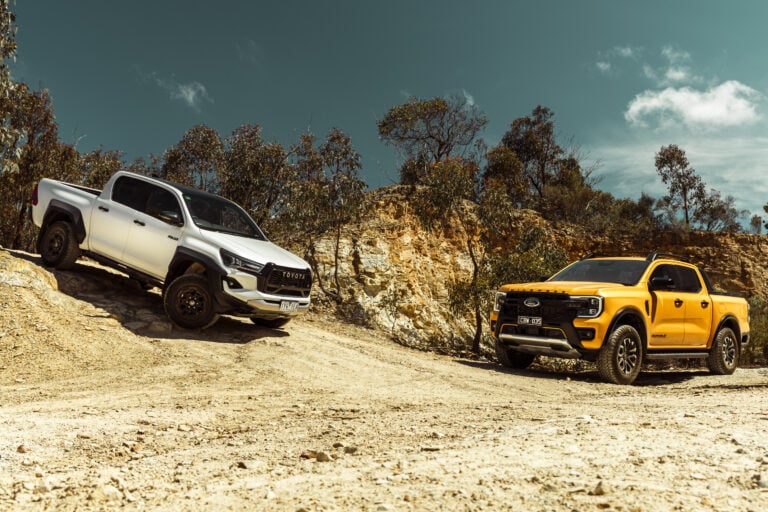 4x4 Comparisons
4x4 ComparisonsFord Ranger Wildtrak vs Toyota HiLux GR Sport comparison review
Ford and Toyota apply the lippy to their big-selling utes to attract the buying public
-
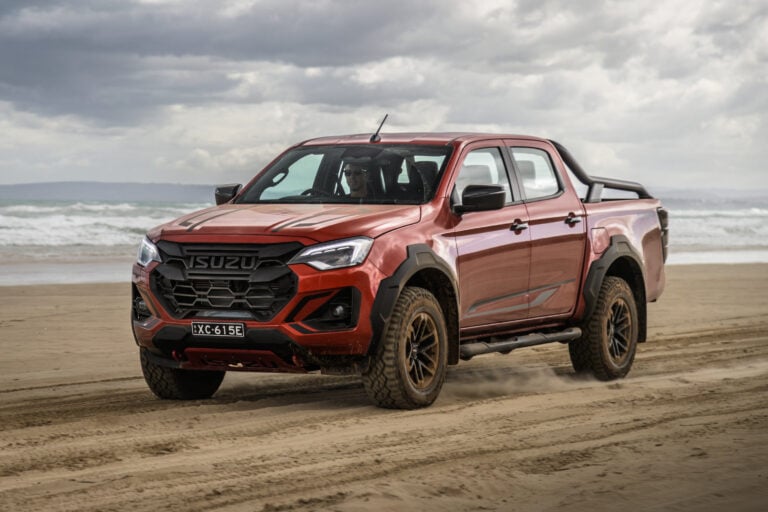 Reviews
Reviews2025 Isuzu D-MAX Blade: First Australian drive
Walkinshaw-fettled Blade sits at the pointy end of the D-MAX line-up
-
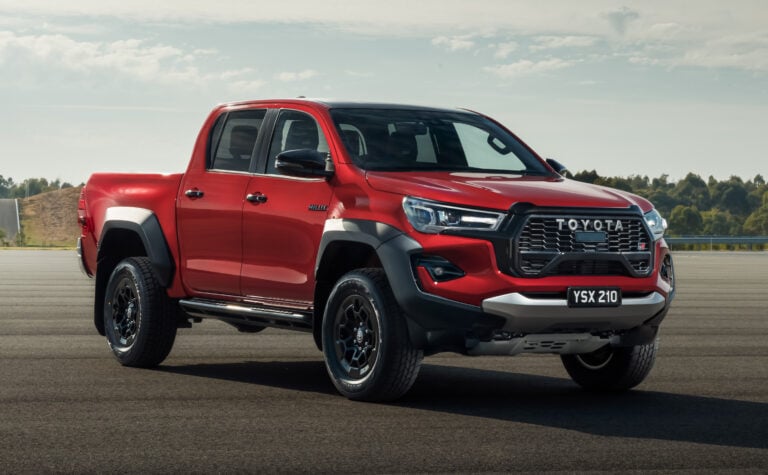 News
News2024 Toyota HiLux GR Sport pricing and features
Toyota has locked in pricing for its $74K super ute packing more grunt and serious suspension mods


